Charcuterie offers a world of flavors — savory, smoky, rich, tangy, and everything in between.
In this guide, I’ll walk you through the different types I’ve tasted, judged, taught, made, and researched from around the world, with honest descriptions and personal insights into each category.
Traditional charcuterie — like dry cured meats, cold smoked fish, or rich pâtés — often centers around ‘umami,’ that deep, savory satisfaction. The saltiness is never overpowering because these meats are sliced thinly, allowing flavors to shine while the fat melts delicately in the mouth.
There are many styles of charcuterie, and each has its own distinct flavor profile depending on how it’s made, what it’s made from, and how it’s served.
I put in links to relevant categories and articles below.
| Charcuterie Category | Taste Description | Examples |
|---|---|---|
| Dry Cured Whole Muscle Meats | Often rich, with balanced saltiness if well made. Intensely savory and moorish. Hundreds of subtle variations. | Prosciutto, Cullatello Coppa/Coppicolla, Lonza/Lonza/Lomo, Bresaola, Pancetta, Lardo, Spalla, |
| Dry Cured Salami | Sometimes tangy from fermentation. Often mildly sweet, with spices like pepper or garlic. Thousands of variations. | Finocchiona, Soppressata, Felino, Milano |
| Fresh Sausages | Moist and juicy (depends on fat content). Flavors vary widely by meat and spice blend — from mild herbs to bold paprika. | Bratwurst, Merguez, Italian Fennel Sausage, Nuremberg Sausage, Spanish Chorizo (Fresh) |
| Pâtés | Creamy, buttery, and full of umami. Often gamey from liver or offal with deep richness. | Chicken Liver Pâté, Pâté de Campagne, Duck Liver Mousse |
| Emulisfied Sausage | Finely ground meat and mixed with fat, spices, and water until a paste, stuffed and cooked. | Mortadella, Fleischwurst, Knackwurst |
| Rillettes & Confit | Soft, rich, and oily. Cooked meat preserved in fat — very umami and decadent. | Duck Rillettes, Pork Rillettes, Duck Confit |
| Bacon (Hot or Cold Smoked) | Salty, smoky, and often sweet. Salt cured, then hot smoked or dried and cold smoked. | Streaky Bacon, Back Bacon, Canadian Bacon (Hot) |
| Cold Smoked Meats (not including bacon) | Salt cured and cold smoked. Traditionally popular in Central & Eastern Europe. | Cold Smoked Salmon, Speck, Smoked Sausage (Kielbasa Wedzona) |
| Hot Smoked Meats | Cooked and smoked at the same time. Smoky, often with salt/sugar balance. Flavor varies by wood and curing method. | Hot Smoked Trout/Salmon, Hot Smoked Chicken |
These are the flavors I’ll explore below — from the rich, gamey depths of pâté to the refined salt-sweet balance of dry-cured ham.
There is also a raw cold smoked slightly emulsified sausage in German called Teewurst, which doesnt fall into these categories.
How to Taste Charcuterie Properly
If you’re new to charcuterie — or even if you’re experienced — how you taste it makes all the difference. A few small techniques bring out the best in flavor, texture, and aroma.
Bring charcuterie to room temperature. This is one of the most overlooked but impactful things you can do. Pull your dry cured meats from the fridge at least 1 to 2 hours before eating. This allows the fat to soften and the flavor compounds to fully bloom. Cold fat can dull both aroma and texture.
Use acidic pairings to balance richness. Charcuterie — especially fattier cuts like pancetta, rillette, or certain salamis — benefits from contrast. Acidic foods help cut through the richness. Here are a few classic pairings:
- Pickled onions or gherkins
- Grainy or Dijon mustard
- Fresh or dried fruits like apple slices or figs
- Crusty sourdough bread with light vinegar dips
- Fermented foods like kimchi or sauerkraut
These combinations aren’t just tradition — they work on a chemical level. Acidity stimulates salivation and resets your palate between bites, helping you experience the complexity of each meat more clearly.
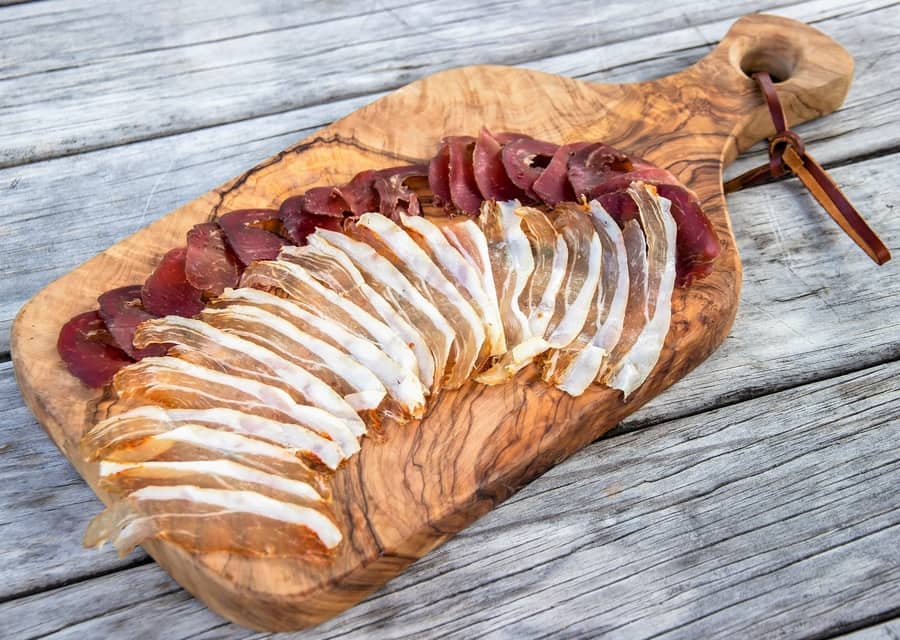
The Taste of Charcuterie
Let’s walk through what to expect from each type of charcuterie — based on years of making, eating, and experimenting across cultures.
- Dry Cured Meats & Salami
- Fresh Sausages
- Pâtés & Rillettes
- Bacon & Pancetta
- Cold Smoked Meats
- Hot Smoked Meats
Dry Cured Salami
Most dry cured salami I’ve come across has some level of tanginess. This flavor comes from fermentation — a critical part of traditional salami making. It adds a mild acidity that brings the meat to life and gives each bite a pleasant brightness.
Not all salami is fermented to the same degree. Some are just subtly tangy, while others have a more pronounced sour edge. That’s why salami can taste so different depending on how it’s made — and that’s not even considering the spices, smoke, or type of meat used.
Many artisan salamis are also lightly cold smoked, adding another layer of complexity. I’ve written more about this unique sour taste of salami here if you’re curious.
There’s a world of difference between small-batch salami made with care, and the supermarket versions mass-produced for shelf life and price. Good salami tastes layered — not just salty meat, but balanced and expressive.
Words to describe the taste of dry cured salami:
- Juicy from pork fat (depending on how dry it is)
- Tangy — from fermentation, subtle in some
- Whole peppercorns — peppery kick
- Faint sweetness from the meat or spices
- Garlic notes — common in many salamis
Fresh Sausages
Fresh sausages are incredibly diverse. I’ve made and tasted recipes using pork, beef, chicken, fish, game meats — and every one of them can taste completely different based on the seasoning. The juicy base always comes from the fat content — usually around 15–30%, like salami.
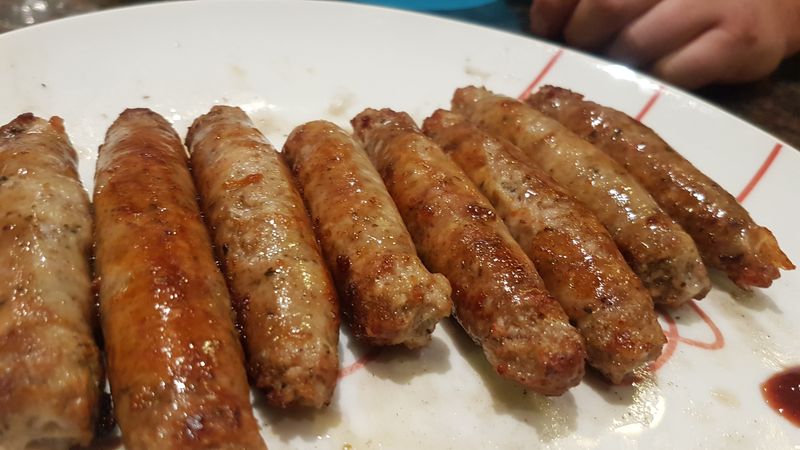
What really sets sausages apart is the spice profile. Central European sausages are often mild, herbal, and clean-tasting — think white pepper and marjoram. Eastern European styles lean heavily on garlic and paprika. And Mediterranean ones? Bold, often with chili, fennel, or wine.
Texture matters too. A coarse grind gives a rustic feel, while finer emulsified sausages can feel smooth or creamy. Some emulsified styles like mortadella are beautiful when done right — others, like generic hot dogs, are just filler-packed and bland.

Emulsified sausages are a big category — they include baloney, spam, wieners, and hot dogs. Sadly, they’re often where low-quality ingredients get hidden behind smooth texture and additives. But there are also premium versions, like Italian Mortadella, that show how good emulsified sausage can be when made traditionally.
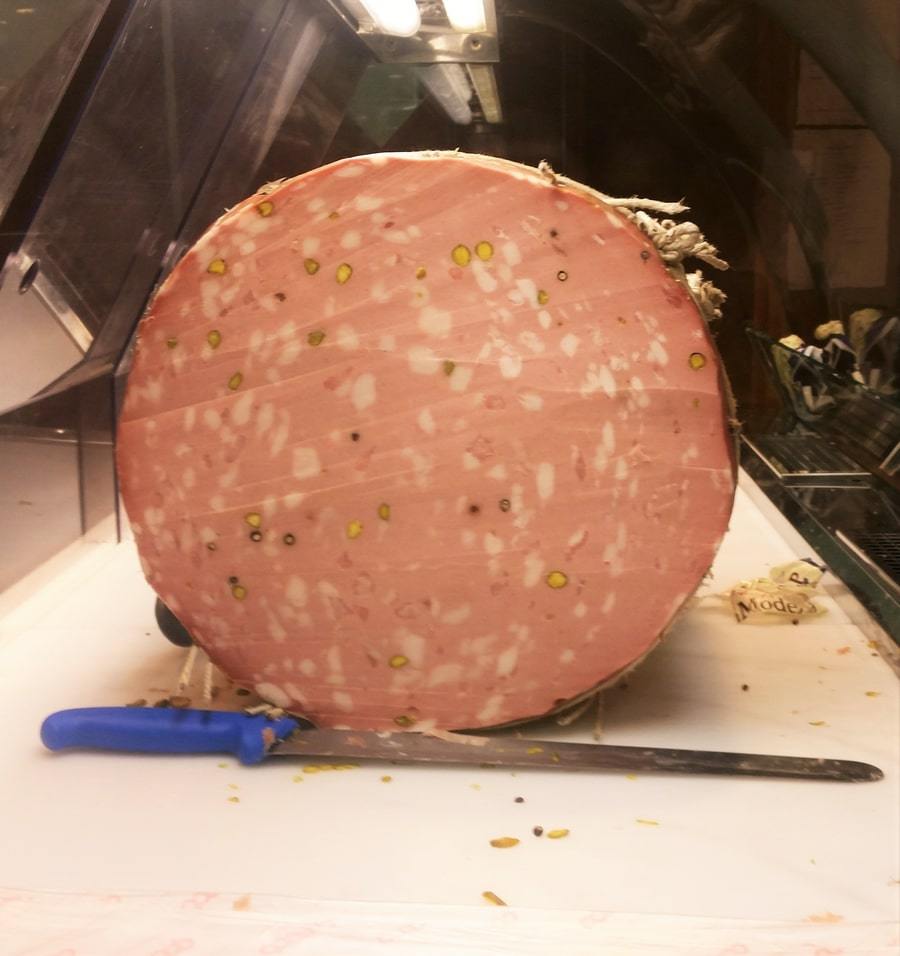
Pâtés & Rillettes
Pâtés are often misunderstood — probably because offal (especially liver) isn’t as popular as it once was. But good pâté is rich, savory, and packed with nutrients. The texture can range from silky and spreadable to rustic and chunky.
Most traditional pâtés use liver as a base — pork, duck, or chicken liver are all common. The iron-rich taste is what gives pâté that deep, almost “gamey” flavor. Herbs, garlic, and a little brandy or wine round it out beautifully.
Words to describe the taste of pâté:
- Creamy and rich
- Buttery texture
- Deep umami and slight bitterness
- Gamey flavor from liver or offal
Rillettes are meatier and less refined — usually pork, duck, or rabbit, slowly cooked and shredded, then preserved in fat. Think of it as pulled meat in a jar, intensely flavored and perfect on crusty bread with pickles.
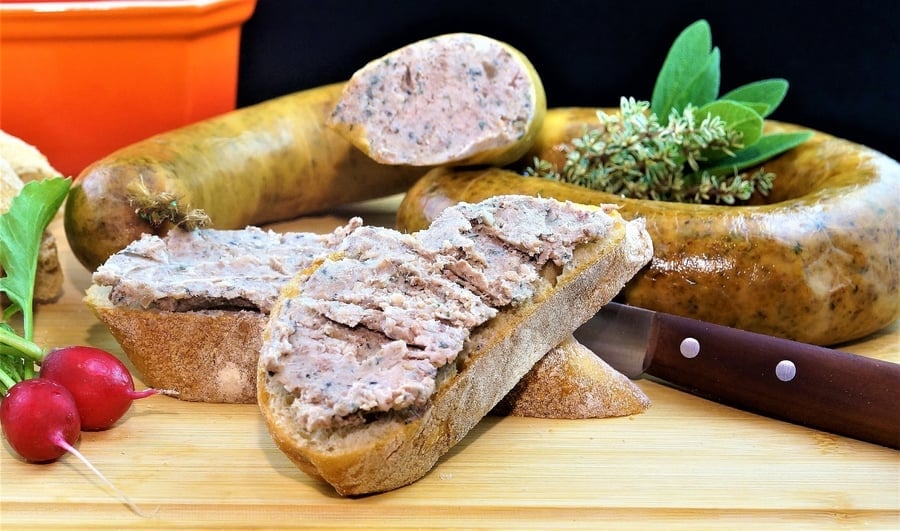
Words to describe the taste of rillettes & confits:
- Rich and soft
- Creamy and fatty
- Deeply savory — intense umami
- Sometimes a little oily (depends on recipe)
For both pâtés and rillettes, the balance of meat, fat, and seasoning is everything. Just a few spoonfuls go a long way — they’re rich for a reason.
Bacon & Pancetta — The Difference and Flavor
Bacon is one of the most recognized forms of cured meat, but few people stop to think about its flavor profile. It’s more than just salty and smoky — good bacon has complexity. Depending on how it’s cured, it might carry sweetness, wood smoke, or even herbal notes.
Commercial bacon often leans heavily on sugar and salt, which people are used to — especially with products like maple-cured or honey bacon. These sugars help balance out the salt and add that craveable finish.
Smoke is where a lot of the flavor action happens. Bacon might be cold smoked, hot smoked, or sometimes even treated with liquid smoke in mass production. The wood type — pecan, hickory, apple — makes a big difference if you’re doing it the traditional way.
Over the years I’ve made all kinds of bacon at home — from whiskey-cured slabs to green-herb rubbed belly. There are endless ways to shape the flavor, depending on what spices and smoking techniques you use.
Words to describe the taste of bacon:
- Porky and pink (thanks to curing salts)
- Salty and sweet — especially in store-bought bacon
- Smoky and rich
Pancetta
Pancetta is the Italian take on cured pork belly — typically dry-cured without smoking. It’s often rolled into a log, tied, spiced, and aged until just the right firmness is achieved. Pancetta is sliced thin and eaten raw or diced for cooking. It’s packed with umami and melts beautifully in the mouth when thinly sliced.
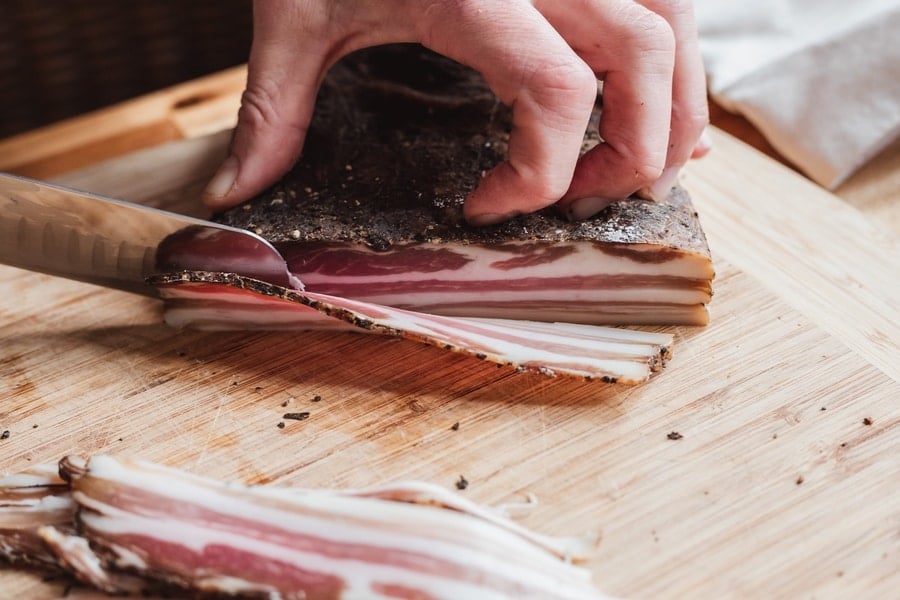
Words to describe the taste of pancetta:
- Soft and melting in the mouth
- Rich and balanced in salt
- Spiced, buttery, and subtle
Cold Smoked Meats
Cold smoking is a traditional way to flavor and preserve meats — especially in Northern and Eastern Europe. Unlike hot smoking, cold smoking doesn’t cook the meat. It’s done at low temperatures over a longer period and paired with salt curing, creating a firm, preserved product like jerky or biltong — but often with pork, salmon, or sausages.
Classic cold smoked salmon is a great example. The smoke intensifies the fish’s umami while the salt locks in preservation. You can vary the smoke flavor by changing wood types — applewood, oak, or pecan each bring their own edge. Most store-bought cold smoked meats won’t say what wood was used, but homemade or artisan ones often do.
Cold smoked meats tend to be quite salty — it’s part of the preservation process. That’s why they’re sliced thin, often paper-thin, to balance out the intensity with texture and mouthfeel.
At home, you can tailor the salt levels and smoke density to your own taste. It’s one of the most satisfying parts of DIY meat curing.
Words to describe the taste of cold smoked meats:
- Smoky and slightly salty
- Deep, dark, concentrated meat flavors
- Wood smoke aroma — varies by wood choice
Hot Smoked Meats
Hot smoking cooks the meat while infusing it with smoke — a technique especially common in American BBQ, but also found in Europe. It’s what gives you things like hot smoked salmon, smoked ham, or smoked sausages. The heat and smoke work together to produce juicy, flavorful results with a cooked texture.
In places like the UK, portable smokers are often used to hot smoke trout or salmon. In America, hot smoking is a go-to for bacon — often combined with sweeteners like brown sugar or maple syrup for extra depth.
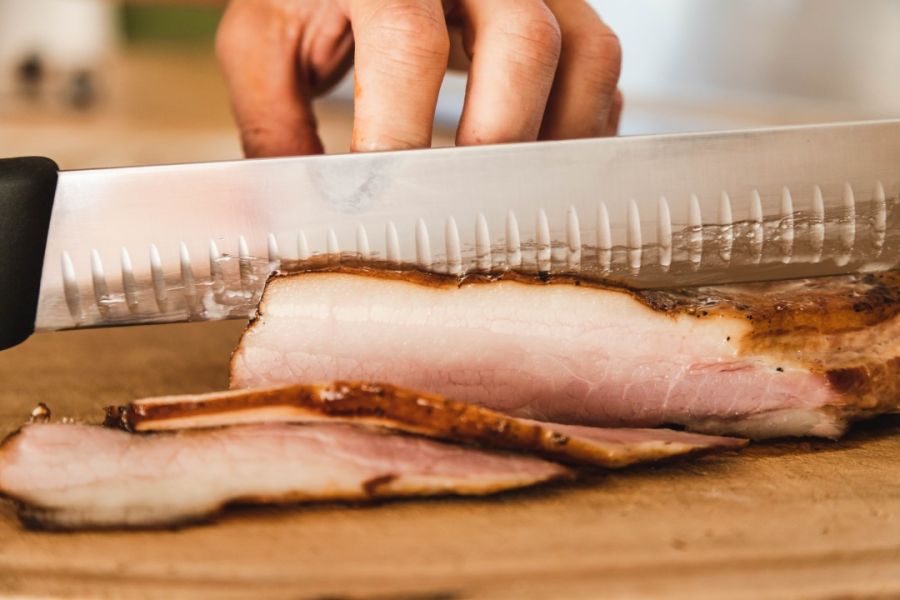
Hot smoking is also used across Central and Eastern Europe, where traditions vary — but the common thread is flavorful, hearty meats finished in smokehouses or brick ovens.
Words to describe the taste of hot smoked meats:
- Smoky, but often more subtle than cold smoked
- Meaty and cooked — soft texture
- Balanced seasoning depending on brine or rub
- Less salty than dry-cured meats
The type of wood used and the technique matter a lot here — hickory gives bold smoke, while fruitwoods like cherry or apple offer milder, sweet notes. It’s one of the most adaptable meat-curing styles for experimenting at home.
Have You Heard of Umami? Dry Cured Meats Nail It
Most people know sweet, salty, sour, and bitter. But there’s a fifth flavor — umami — that defines many charcuterie meats. Umami is that deep, savory taste that lingers and satisfies. It’s rich, earthy, and mouth-filling.
Dry cured meats are especially full of umami because the aging process concentrates flavors, breaks down proteins, and draws out natural glutamates — the molecules behind umami. That’s why wafer-thin prosciutto or a sliver of lonza tastes so satisfying despite its size.
Other foods rich in umami include:
- Anchovies
- Parmesan cheese
- Mushrooms
- Tomatoes
- Kimchi or fermented foods
- Seafood like mussels or shrimp
When paired with charcuterie, these ingredients often elevate the experience — creating depth and harmony on a well-balanced board.
If you’re curious, here’s a great primer on umami-rich foods and how they work.
A Quick Overview: Modern vs Traditional Charcuterie
Modern Charcuterie
Today’s charcuterie boards are often hybrids — mixing traditional dry cured meats with cheeses, dips, nuts, fresh fruit, and spreads. While salami and prosciutto remain staples, modern boards reflect global influences and creative flair.
I’ve written more about what to do with charcuterie leftovers — because these boards can get generous!
Condiments like mustard, pesto, fig jam, beetroot relish, or pickled veg all complement fatty meats. And don’t underestimate how good a few fresh strawberries or slices of melon can be next to salty pancetta or jamón.
Traditional Charcuterie
The word “charcuterie” comes from French — and traditionally included dry cured pork, offal-based pâtés, terrines, rillettes, and confits. Salt, fat, and time were the core tools used to preserve meat before refrigeration.
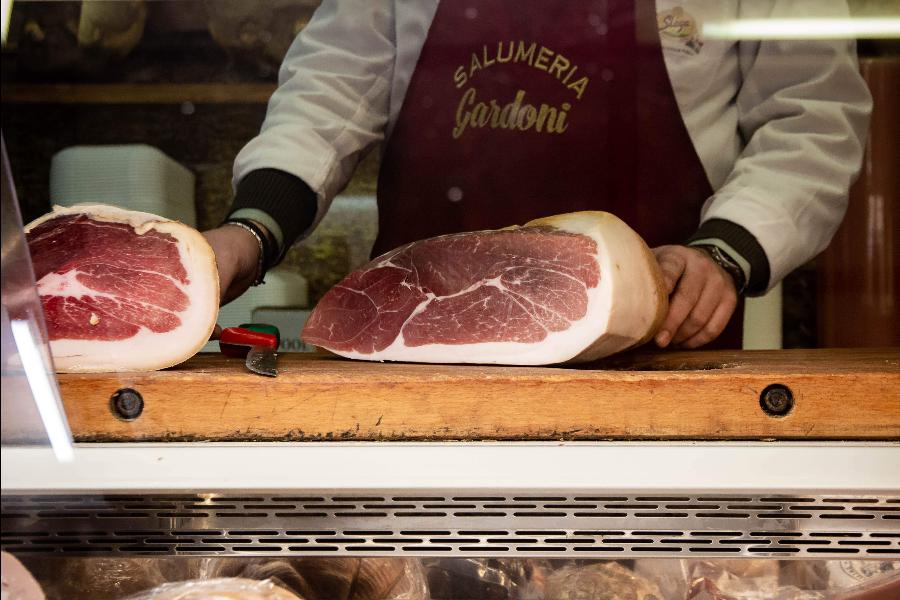
Examples of traditional dry cured meats:
- Parma Ham / Prosciutto
- Jamón Ibérico
- Lonza
- Bresaola
- Coppa
What makes these meats so special is the simplicity — often just meat, salt, and time. But they’re also shaped by regional traditions, pig breeds, and feeding practices. In Parma, for example, pigs are fed whey from Parmigiano-Reggiano production, which influences the ham’s flavor.
Jamon Iberico pigs, on the other hand, are free-range and finished on acorns. These small differences create huge flavor outcomes — and explain the premium pricing of some traditional meats.
Words to describe traditional dry cured meats:
- Buttery, melt-in-your-mouth fat
- Soft, thin slices
- Balanced seasoning (not overly salty)
- Deep meaty umami
- Porky but delicate
Expert Tip: Cut It Thin, Serve It Right
To truly appreciate the flavor of cured meats like prosciutto, pancetta, or lonza — slicing matters.
If it’s a deli, salumeria or supermarket requested for dry cured meats 1mm or less. nearly translucent is what I recommend. Extremely hard to do without a decent deli slicer, for home use I wrote an article on what is criteria.
Always go wafer thin. Thick slices can make even the best charcuterie seem chewy or overly salty. If you don’t have a deli slicer, a sharp knife and chilled meat help with thinner cuts.
And remember — let the meat sit at room temperature for 1–2 hours before serving. That’s when the fat softens and the aromas bloom, unlocking the full flavor profile.
Alternatives to Classic Charcuterie Meats
If you’re not into pork or are looking for something a little different, there are fantastic alternatives that still give that cured, savory hit:
- Duck Prosciutto — dry cured duck breast, rich and buttery
- Venison Coppa — gamey and earthy, pairs beautifully with fruit
- Lamb Merguez Sausage — spicy and bold, cooked fresh
Charcuterie doesn’t have to follow old rules — explore and pair flavors that match your preferences and ethics.
However, I appreciate the classics and traditional of a few thousands years across Italy.
What does bacon taste like?
Great bacon is slightly salty, smoky, sweet, and rich with fat. The balance depends on the curing and smoking method.
What is pâté made of?
Pâté often contains liver or offal blended with fat, herbs, and spices. The result is a creamy, savory spread packed with umami.
Why slice charcuterie thin?
Thin slices help balance saltiness and fat, making the meat melt in the mouth and release more aroma and flavor.
How long should charcuterie sit before serving?
Let it come to room temperature for 1–2 hours. This brings out the full texture and flavor — especially in dry cured meats.
What makes dry cured meats taste so good?
Time is key — the slow drying process concentrates flavor, softens the meat, and enhances umami through natural fermentation.
Got a favorite cured meat or flavor combo I missed? Drop a comment below — I’d love to hear your thoughts or questions!

Tom Mueller
For decades, immersed in studying, working, learning, and teaching the craft of meat curing, sharing the passion and showcasing the world of charcuterie and smoked meat. Read More
